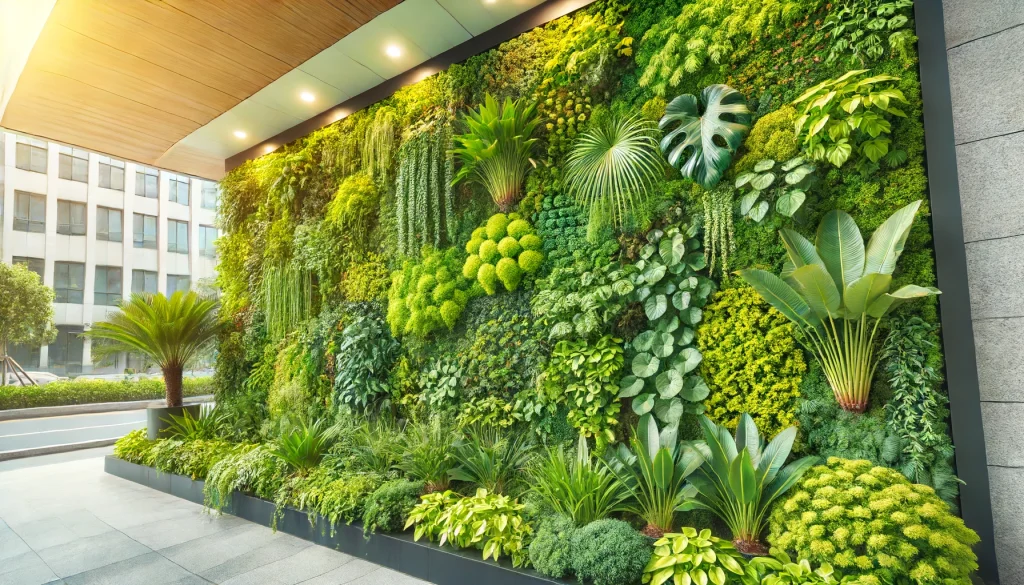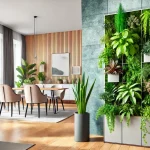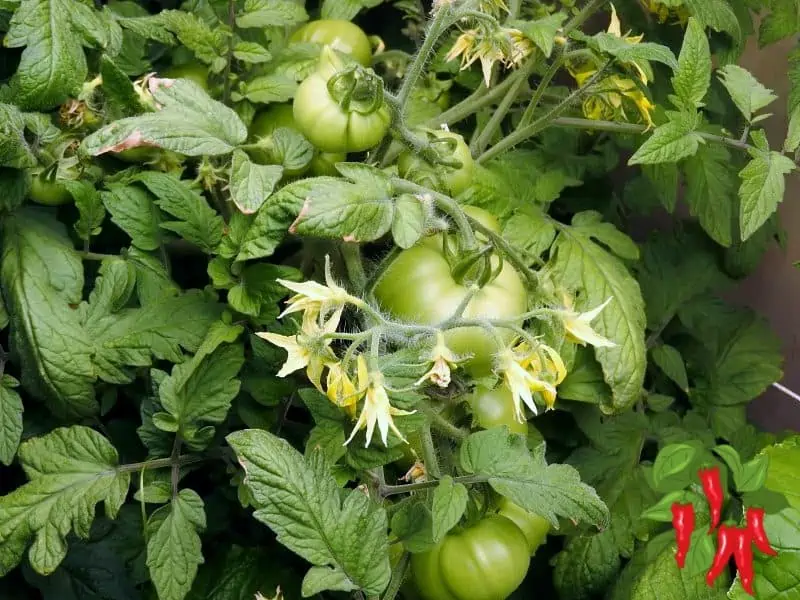This post may contain affiliate links. If you buy something from one of our links we may earn a commission. Thanks

Maintenance of vertical gardens can seem tricky at first. Without proper care, these unique green spaces might struggle. But don’t worry!
With the right tips, you can keep your vertical garden thriving and beautiful.
Vertical Garden Maintenance Key Takeaways
- Vertical Garden Maintenance involves regular watering, proper nutrient management, and pest control.
- Ensure your garden receives enough light and trim plants regularly to promote healthy growth.
- Consistent care keeps your vertical garden thriving.
Maintenance of Vertical Gardens
Maintaining a vertical garden can seem daunting due to its unique setup. Without proper care, these gardens can struggle, leading to wasted effort and resources.
After reading this blog post you will understand the key maintenance practices ensuring a thriving, beautiful vertical garden.
I. Understanding Vertical Gardens
Worth Garden 36 Pockets Self Watering Vertical Planters Indoor Outdoor Living Wall Mounted
Vertical gardens are a fantastic way to maximize limited space and add greenery to urban environments.
They offer aesthetic and practical benefits, making them a popular choice for modern gardeners.
What is a Vertical Garden?
Vertical gardens, also known as living walls, are gardens that grow upward using supports like trellises or other structures.
Unlike traditional gardens, they utilize vertical space, perfect for small areas or urban settings.
Benefits of Vertical Gardens:
- Space-saving: Ideal for small apartments or urban areas with limited ground space.
- Aesthetic appeal: Adds a striking visual element to any space.
- Improved air quality: Plants help filter and purify the air.
- Thermal insulation: Can help regulate indoor temperatures.
- Biodiversity: Encourages a variety of plant species and supports urban wildlife.
Common Uses and Examples
Vertical gardens can be used in various settings and for different purposes:
- Indoor Decor: Living walls can be a beautiful addition to interiors, bringing a touch of nature inside.
- Outdoor Walls: Perfect for creating green facades on buildings.
- Urban Agriculture: Growing herbs, vegetables, and small fruits in city environments.
- Noise Reduction: Plants can help absorb sound, making them useful for noisy areas.
With these versatile uses, vertical gardens are becoming an essential part of urban gardening and sustainable living.
II. Care – How to Take Care of a Vertical Garden
Cloth 12 Pocket Hanging Vertical Garden Wall Planter for Yard Garden Home
Proper care is essential to keep your vertical garden healthy and vibrant. This section covers the key aspects of watering and nutrient management, ensuring your garden thrives.
Watering Schedule
Consistent watering is crucial for vertical gardens because they tend to dry out faster than traditional gardens.
Importance of Consistent Watering:
- Vertical gardens lack the extensive soil base that traditional gardens have, leading to quicker drying.
- Ensures plants get the necessary moisture to grow and stay healthy.
Recommended Frequency and Methods:
- Soil-based Systems: Water 2-3 times a week, adjusting based on climate and plant needs.
- Hydroponic Systems: Water continuously with nutrient-rich solutions.
- Aeroponic Systems: Mist roots several times a day to maintain moisture and nutrient levels.
Watering Methods
Different irrigation systems can be used to keep your vertical garden well-watered.
Overview of Irrigation Systems:
- Drip Irrigation: Delivers water directly to the base of each plant, minimizing waste.
- Self-Watering Systems: Use reservoirs to provide a steady water supply, reducing maintenance.
- Hydroponics: Circulates nutrient-rich water through plant roots, ideal for urban setups.
Advantages of Automated Systems and Manual Checks:
- Automated Systems: Ensure consistent watering, reduce the risk of under or over-watering, and save time.
- Manual Checks: Allow for adjustment based on plant needs, ensuring no part of the garden is neglected.
Nutrient Management
Providing the right nutrients is vital for the growth and health of your vertical garden.
Importance of Fertilization:
- Regular fertilization is necessary to compensate for the limited soil volume.
- Supports robust plant growth and vibrant foliage.
Selecting the Right Fertilizers:
- Water-Soluble Fertilizers: Easy to apply with irrigation systems, ensuring even distribution.
- Slow-Release Fertilizers: Provide a steady supply of nutrients over time, reducing the frequency of application.
Incorporating Beneficial Microorganisms:
- Enhances nutrient uptake and promotes healthy plant growth.
- Can be added through specialized soil mixes or compost teas.
By following these guidelines, you’ll ensure your vertical garden receives the care it needs to flourish.
III. Responsibilities – Garden Maintenance Responsibilities
Maintaining a vertical garden involves regular inspections and timely actions to keep your plants healthy and vibrant.
Here are some key responsibilities to ensure your garden thrives:
Regular Inspections
Frequent checks are essential for a healthy vertical garden. By keeping an eye on your plants, you can catch and address issues early.
Checking for Pests and Diseases:
- Inspect plants regularly for any signs of pests such as aphids, spider mites, or fungal infections.
- Look for discoloration, spots, or wilting leaves, which can indicate disease.
Identifying Signs of Plant Stress:
- Monitor for symptoms like yellowing leaves, stunted growth, or unusual spots.
- Take swift action by removing affected parts and treating the problem with appropriate solutions.
Pruning and Trimming
Proper pruning and trimming are crucial for maintaining plant health and enhancing the aesthetics of your vertical garden.
Techniques for Pruning:
- Use sharp, clean tools to make precise cuts.
- Remove dead or diseased parts to promote healthy growth.
Maintaining Plant Health and Aesthetics:
- Regularly trim plants to prevent overcrowding and ensure each plant receives adequate light.
- Shape plants to enhance their appearance and encourage fuller growth.
Frequency and Methods:
- Prune most plants once or twice a year, adjusting based on specific plant needs.
- Ensure proper airflow and light exposure by keeping plants well-spaced and not allowing them to overshadow each other.
By performing these regular maintenance tasks, you can keep your vertical garden healthy, vibrant, and visually appealing.
IV. Cons – Cons of Vertical Gardening
While vertical gardening has many benefits, it’s important to be aware of some potential drawbacks.
Understanding these challenges can help you better prepare and find solutions.
Challenges and Drawbacks
Vertical gardens can face several issues that traditional gardens might not encounter. Here are a few common challenges:
Limited Plant Variety:
- Not all plants are suitable for vertical gardening. Certain species with deep root systems or specific space requirements may not thrive in this setup.
Maintenance Access:
- Reaching all parts of a vertical garden can be difficult, especially in larger installations. This can make routine tasks like pruning and watering more challenging.
Dependency on Irrigation Systems:
- Vertical gardens often rely heavily on irrigation systems. Any failure in these systems can quickly affect the health of your plants.
Solutions to Address These Challenges
Fortunately, there are ways to address these potential issues:
Plant Selection:
- Choose plants that are well-suited to vertical gardening, such as those with shallow roots, succulents, or those adapted to climbing.
Design and Placement:
- Plan your vertical garden layout to ensure easy access to all areas. Use modular systems that allow for individual sections to be maintained separately.
Reliable Irrigation:
- Invest in a quality irrigation system and conduct regular maintenance checks. Consider using automated systems with backup options to prevent any disruption in the water supply.
By being aware of these challenges and implementing these solutions, you can enjoy the benefits of vertical gardening while minimizing potential drawbacks.
V. Requirements – What Do You Need for a Vertical Garden?
Vertical Garden Wood Plant Wall Mount Flower Pot Holder
Starting a vertical garden involves gathering the right materials and tools. Careful planning and selecting the appropriate structure and growing medium are essential for success.
Materials Needed
Setting up a vertical garden requires a few key materials. Here’s what you’ll need:
Essential Materials and Tools:
- Structure/Support System: Trellises, wall-mounted panels, or free-standing frames.
- Containers: Pots, pocket systems, or modular planters designed for vertical growth.
- Growing Medium: Soil, coco coir, or hydroponic setups depending on plant requirements.
- Irrigation System: Drip irrigation, self-watering systems, or hydroponic setups to ensure consistent moisture.
- Plants: Choose plants suitable for vertical gardening, such as herbs, leafy greens, or climbing plants.
- Tools: Pruning shears, watering can, trowel, and other basic gardening tools.
Considerations for Choosing the Right Structure and Growing Medium
Selecting the right structure and growing medium is crucial for the health and sustainability of your vertical garden.
Structure:
- Stability: Ensure the structure is stable and can support the weight of plants, soil, and water.
- Accessibility: Choose a design that allows easy access for maintenance and harvesting.
- Material: Opt for durable materials like treated wood, metal, or sturdy plastic that can withstand outdoor conditions.
Growing Medium:
- Soil: Use a well-draining soil mix enriched with organic matter.
- Coco Coir: A sustainable alternative to peat moss, offering good moisture retention and aeration.
- Hydroponics: Ideal for urban environments, providing a soil-less option that delivers nutrients directly to plant roots.
By gathering these materials and carefully planning your vertical garden setup, you can create a thriving and beautiful green space.
VI. Maintenance – How Are Vertical Gardens Maintained?
90 Pockets Wall Planter Wall Mounted Grow Bag Outdoor Indoor Vertical Gardening Flower Container
Maintaining a vertical garden requires a combination of preventive and reactive maintenance strategies.
Proper planning and the use of technology can make this process more efficient and effective.
Preventive vs. Reactive Maintenance
Regular maintenance is key to the health and longevity of your vertical garden. Here’s why preventive maintenance is so important:
Importance of Preventive Maintenance and Planning:
- Consistent Care: Regular checks and maintenance tasks prevent small issues from becoming major problems. This includes routine watering, pruning, and inspecting for pests.
- Longevity: Preventive maintenance helps extend the life of your garden by ensuring that plants remain healthy and vibrant.
- Efficiency: Planning maintenance activities can save time and resources in the long run by reducing the need for emergency interventions.
Preventive Maintenance Tasks:
- Regular Watering: Ensuring your irrigation system works correctly and plants receive adequate moisture.
- Pruning and Trimming: Regularly removing dead or overgrown parts of plants to promote healthy growth.
- Pest and Disease Monitoring: Inspecting plants for signs of pests or diseases and taking action before they spread.
Reactive Maintenance:
- Addressing Issues: Quickly responding to any problems that arise, such as pest infestations, diseases, or irrigation system failures.
- Repairs: Fixing broken supports or replacing damaged plants promptly to maintain the garden’s integrity.
Use of Technology and Sensors for Efficient Garden Monitoring
Modern technology can greatly enhance the maintenance of vertical gardens by providing real-time data and automation:
Benefits of Using Technology:
- Sensors: Install sensors to monitor soil moisture, temperature, and humidity. These sensors can alert you to changes that need attention, ensuring optimal growing conditions.
- Automated Systems: Automated irrigation and lighting systems can ensure plants receive consistent care without daily manual intervention.
- Data Analysis: Use data from sensors to analyze trends and make informed decisions about watering schedules, nutrient management, and pest control.
Implementing Technology:
- Choose Reliable Systems: Invest in high-quality sensors and automated systems to minimize maintenance and maximize efficiency.
- Regular Updates: Keep your systems updated and perform regular checks to ensure they are functioning correctly.
By combining preventive maintenance with the latest technology, you can ensure your vertical garden remains healthy, vibrant, and easy to manage.
VII. Function – What is the Purpose of a Vertical Garden?
Vertical gardens offer numerous benefits and uses, making them a popular choice for enhancing various environments.
They are not only visually appealing but also provide functional advantages.
Benefits and Uses
Vertical gardens serve multiple purposes, particularly in urban settings where space is limited. Here are some key benefits:
Enhancing Urban Spaces:
- Maximizing Space: Vertical gardens utilize vertical areas, making them ideal for small apartments, balconies, or urban landscapes where ground space is scarce.
- Beautification: They add a lush, green aesthetic to any space, transforming bland walls into vibrant, living art.
Improving Air Quality:
- Natural Air Filters: Plants in vertical gardens can help filter pollutants and improve indoor air quality by absorbing toxins and releasing oxygen.
- Humidification: They also add moisture to the air, which can be beneficial in dry urban environments.
Growing Fresh Produce:
- Urban Agriculture: Vertical gardens can be used to grow herbs, vegetables, and small fruits, making it easier to access fresh produce even in city settings.
- Self-Sufficiency: They enable urban dwellers to grow their own food, promoting healthier eating habits and reducing the need for store-bought produce.
Aesthetic and Functional Benefits
Vertical gardens provide both aesthetic and functional benefits, making them a valuable addition to various environments:
Aesthetic Benefits:
- Visual Appeal: They create a visually striking focal point, adding beauty and interest to otherwise dull or unused spaces.
- Design Flexibility: Vertical gardens can be designed to fit any space, from small indoor installations to large outdoor walls, allowing for creative and personalized designs.
Functional Benefits:
- Insulation: Vertical gardens can act as natural insulators, helping to regulate indoor temperatures by keeping buildings cooler in the summer and warmer in the winter.
- Noise Reduction: They help reduce noise pollution by absorbing sound, making them ideal for noisy urban areas or busy indoor spaces.
By incorporating vertical gardens into your space, you can enjoy a range of benefits that enhance both the environment and your quality of life.
VIII. Cost – How Much Does it Cost to Maintain a Vertical Garden?
Maintaining a vertical garden involves various costs, from initial setup to ongoing maintenance.
Understanding these expenses can help you plan and budget effectively.
Cost Breakdown
Initial Setup Costs:
- Structure/Support System: Costs vary depending on the size and type of structure. Wall-mounted panels, trellises, and free-standing frames can range from $50 to several hundred dollars.
- Containers: Pocket systems, pots, or modular planters typically cost between $20 and $100 per unit.
- Growing Medium: Soil, coco coir, or hydroponic media can cost around $10 to $50, depending on the quantity and type.
- Irrigation System: Basic drip irrigation systems start at around $30, while more advanced self-watering systems can exceed $100.
- Plants: Costs vary widely based on plant type and quantity. Herb and vegetable seedlings generally range from $2 to $10 each, while ornamental plants can be more expensive.
- Tools: Basic gardening tools, such as pruning shears and trowels, typically cost between $10 and $50.
Ongoing Maintenance Expenses:
- Water and Nutrients: Monthly water bills may increase slightly, while fertilizers and nutrients can cost $10 to $30 per month.
- Pest Control: Organic pest control products range from $10 to $40.
- Replacement Plants: Occasionally, plants may need to be replaced, costing an average of $20 to $50 annually.
- System Maintenance: Regular maintenance of irrigation systems and structures can incur minor costs, typically around $20 to $50 annually.
Tips for Budgeting and Cost-Effective Solutions
Plan Your Budget:
- Start Small: Begin with a small vertical garden and gradually expand as you gain experience and assess costs.
- DIY Options: Consider building your own support structures and planters using recycled materials to save money.
- Shop Smart: Purchase plants and materials during sales or from local nurseries to reduce costs.
Cost-Effective Solutions:
- Automated Systems: Investing in automated irrigation can reduce water waste and lower long-term costs.
- Quality Over Quantity: Choose high-quality materials and plants that may have higher upfront costs but offer better longevity and performance.
- Regular Maintenance: Perform regular maintenance to prevent costly repairs or plant replacements.
By understanding the costs and implementing cost-effective strategies, you can maintain a beautiful and thriving vertical garden without breaking the bank.
Vertical Garden Maintenance FAQs
Maintaining a vertical garden involves understanding its unique needs and addressing any potential challenges.
Here are some frequently asked questions to help you keep your vertical garden thriving.
Q: How to maintain your vertical garden?
A: To maintain your vertical garden, ensure consistent watering, regular pruning, pest control, and nutrient management. Check your plants daily for any signs of distress, adjust watering schedules based on weather and plant needs, and provide the necessary nutrients through appropriate fertilizers.
Q: Are vertical gardens hard to maintain?
A: Vertical gardens require regular attention but can be easily managed with proper planning and the right tools. Setting up automated irrigation systems and using disease-resistant plants can simplify maintenance significantly.
Q: Are there any drawbacks to using vertical gardens?
A: Some drawbacks include limited plant variety due to space constraints, difficulty accessing certain areas for maintenance, and dependency on irrigation systems. However, these issues can be mitigated with thoughtful design and regular upkeep.
Q: How to protect vertical gardens?
A: Protect your vertical garden by conducting regular inspections for pests and diseases, choosing plants that are suited to your environment, and implementing preventive measures like using organic pesticides and ensuring good air circulation.
Q: How long do vertical gardens last?
A: With proper care, vertical gardens can last many years. The longevity depends on the quality of the materials used, the plants selected, and how well the garden is maintained. Regular maintenance and timely replacement of parts and plants are essential.
Q: What are the challenges of vertical gardening?
A: Challenges include selecting suitable plants, ensuring consistent irrigation, and maintaining access to regular care. Additionally, vertical gardens can require more frequent watering and may need specialized fertilizers to thrive.
Q: What are the disadvantages of vertical gardening?
A: Disadvantages include higher initial setup costs, ongoing maintenance expenses, and potential structural issues over time. Vertical gardens also require more careful planning and regular maintenance compared to traditional gardens.
Q: How often should I water my vertical garden?
A: Vertical gardens generally need more frequent watering than traditional gardens due to their design. Depending on the system and plant types, you might need to water daily or every other day, especially during hot weather.
Q: Is it difficult to maintain a vertical garden?
A: While it can be challenging, maintaining a vertical garden is manageable with the right knowledge and tools. Using automated systems, choosing low-maintenance plants, and conducting regular inspections can make the process easier and more enjoyable.
How To Maintain a Vertical Garden Conclusion
Maintaining a vertical garden may seem like a daunting task, but with the right knowledge and practices, it can be a rewarding and enjoyable experience. Here’s a summary of key points to keep in mind.
Summary of Key Maintenance Practices
To ensure your vertical garden thrives, focus on:
- Regular Watering: Keep your plants hydrated, adjusting frequency based on your garden’s specific needs.
- Nutrient Management: Use appropriate fertilizers and maintain a balanced nutrient supply.
- Pest and Disease Control: Conduct regular inspections and take swift action to manage any issues.
- Pruning and Trimming: Regularly prune and trim plants to promote healthy growth and prevent overcrowding.
Overcoming Challenges
Vertical gardens come with their own set of challenges, but these can be managed with proper planning and tools:
- Access and Maintenance: Design your garden for easy access to all areas.
- Irrigation Systems: Invest in reliable systems and conduct regular maintenance checks.
- Plant Selection: Choose plants suited for vertical growth to ensure success.
Enjoying the Benefits
Vertical gardens offer numerous benefits that enhance both urban and indoor spaces:
- Space Efficiency: Ideal for maximizing limited space.
- Aesthetic Appeal: Adds beauty and a touch of nature to any environment.
- Functional Advantages: Improves air quality, provides thermal insulation, and reduces noise.
Final Thoughts
Embrace the unique aspects of vertical gardening and enjoy the process. With consistent care and attention, your vertical garden can flourish, providing beauty, fresh produce, and environmental benefits. Happy gardening!
Read more: Indoor Vertical Gardening: Start Your Indoor Garden Now
Visit my Amazon Influencer Page for videos and gardening products Grow Your Own Garden











